|
- Catalog (in stock)
- Back-Catalog
- Mail Order
- Online Order
- Sounds
- Instruments
- Projects
- History Face
- ten years 87-97
- Review Face
- our friends
- Albis Face
- Albis - Photos
- Albis Work
- Links
- Home
- Contact
- Profil YouTube
- Overton Network
P & C December 1998
- Face Music / Albi
- last update 03-2016
|
1. Jan Oy, (love song) - Vasburakan - 2:43
2. Jaghatzs Patik-Patik, my flour is sifted into grains (love song) - Aparan (Aragatsotn region) - 1:34
3. Yes Saren Gookayi, I came from the mountain (love song) - 1:34
4. Es Aroon, this stream (lyric song) - 1:31
5. Dzovun Khavkum Ker, a sea bird (song of the emigrants) - Vasburakan - 3:44
6. Kot oo Kes, a measure and a half (humorous song) - Vasburakan - 2:22
7. Loosnakn Ichav Sari Tak, the moon descended from the mountain (love song) - Aparan (Aragatsotn region) - 2:10
8. Hoy Nar, (dance song) - Vasburakan - 1:22
9. Goleh Hoy Nar, hey, Goleh! (dance song) - Vasburakan - 2:33
10. Hov Arek Sarer Djan, make me cool, dear mountains (love song) - 3:13
11. Im Sokhakin, my nightingale (song of the emigrants) - Shatak - 3.16
12. Garnan Gootan, the spring plow (lyric song) - 1:46
13. Aravot Looso, morning light (spiritual song) - 0:58
14. Anoosh Merik, sweet mother (wedding song) - 1:25
15. Merik-Merik, mother-mother (wedding song) - Taron region - 2:46
16. Aravotun Demin, approach of morning (wedding song) - Alashkert (Taron) - 5:12
17. Kaghenk Berenk, pick, bring (wedding song) - 1:01
18. Tagvori Mer, our King (wedding song) - 1:36
19. Tikranakerti Oror, lullaby of Tikranakert - Tikranakert - 3:29
20. Yerkinkn Ampel e, the sky is covered by clouds (love song) - 2:13
21. Yes oo Yars Jahel Enk, my lover and I are young (love song) - Sasun - 1:41
22. Im Mourad, my Mourad (love song) - Vasburakan - 3:31
23. Gootan Yerg, plough of spring (work song) - 4:32
24. Msho Geghen, a village of Mush (lyric song) - Mush (Taron region) - 2:15
25. Akh Ninar, an expression to the godness Nar (ceremonial song) - Sasun - 1:45
26. Khooti Gorani, Gorani from Khoot (ceremonial song) - Mush (Taron region) - 7:19
27. Dle Yaman, (lyric song) - Vasburakan - 6:03
- Several songs in this collection do not have a region listed. This is because these songs were recorded by the priest Komitas in Echmiadzin (Ararat region) from Armenians who had come from various regions of Historical Armenia, or were recorded by Komitas as he traveled throughout the Armenian homeland (Anatolia), but he did not record the regions of these songs. These are: 14. Anoosh Merik, 17. Kaghenk Berenk, 18. Tagvori Mer, 20. Yerkinkn Ampel e, 10. Hov Arek Sarer Djan, 3. Yes Saren Gookayi, 4. Es Aroon, and 12. Garnan Gootan.
Songs of Armenia
The text and meaning of the songs determine their theme or genre. The Armenian folk songs are classified into the following genres:
|
- work songs, including women's work songs, and "horovels", that is plowing songs or songs of the field |
|
- ceremonial songs (i.e. for weddings, funerals etc.) |
|
- epic songs - In Armenian music tradition, epic songs are thematically distinct in two categories.
|
The one with the bigger repertory contains mythological themes of pagan Armenia like "Haik and Bel", "Dork Angegh", "Ara and Shamiram" and those classified as "fables" |
|
The others are the so-called heroic songs telling about the history and the traditions of these people and their heroes, such as e.g. "Sasuntzi Davith" dealing with the adventures of the hero of epics David of Sasun in his defense against infidel Arab invaders from Egypt and Persia. The epic was based on oral tradition that presumably dates from the 8th to the 10th century; it was widely known from the 16th through the 19th century and was finally written down in 1873. |
|
|
- historical songs - These songs reflect Armenian history and reality. Through such songs, we can learn about the real events of Armenian history in various times
|
|
- dance songs (songs sung during a dance) |
|
- humorous songs |
|
- lullabies
|
|
- lyric songs, love songs |
|
- songs of the emigrants (these songs tell stories about tragedy, persecution, emigration, torture, and the grief of the Armenian people). |
Work songs
All work songs describe something of the working process and are sung to accompany work. Songs of the fields are called "horovels". This is a large, manysided genre, in which the peasant expresses his thoughts, desires, and his love for the nature, all combined with a deep respect for his work. Singing helps him, not only during the period of work, but to endure and overcome the trials and difficulties of life.
23. Gootani Yerg, plough of spring
- Aleksan Harutyunyan, voc - Nairi Musoyan, duduk - Norayr Kartashian, sring
|
Come, plough, till the soil. / The day is passing, becoming our nourishment. / Turn the soil; I die for your ploughshare. / Glory to God, plough.
|
Te lyric of this folk song were written by the 20th century poet Hohvannes Toumanian; therefore no region is listed.
|
Ceremonial songs
Ceremonial songs are sung at weddings, at funerals (songs of sadness and mourning) and on various other holidays and at festive celebrations. Every ceremony or holiday has its particular ceremonial song. The roots of this genre are to be found in pagan times, but with the beginning of the Christian era, they have assumed new meanings and a new importance, which they have maintained till today.
14. Anoosh Merik, sweet mother (wedding song)
- Noune Atanasian, voc
|
Mother, your motherhood, / oh, oh, sweet mother. / I am going to another's house. / I still haven't left, oh, mother.
|
15. Merik-Merik, mother-mother (wedding song) - Taron
- Hasmik Harutyunyan, voc
|
The groom came from the East. / They took the bride from Meghraged River. / I am crying but I am going to get married.
|
The groom is the ancient Armenian god Vahakn, and the bride is the goddess Astghik. When Vahakn comes for Astghik, she is bathing in Meghraged River.
|
16. Aravotun Demin, approach of morning (wedding song) - Alashkert (Taron)
- Hasmik Harutyunyan, voc - Karine Hovhannisian, kanun
|
Mother, arise, arise, there is light in the roof hole. / My child, they are taking you to be married. / The time is near. / At dawn, they came to take her. / Your father, your mother, I sacrifice myself for you. / On your new journey.
|
17. Kaghenk Berenk, pick, bring (wedding song)
- Noune Atanasian, voc
|
Pick, bring flowers for our groom. / It was the flower named balsam, / which must turn green before it can blossom.
|
18. Tagvori Mer, our King (wedding song)
- Noune Atanasian, voc
|
Come out, our king. / See what we have brought for you. / We have brought you a bride. / We have brought you a bearer of water. / A baker of lavosh...
(A round, thin, crisp bread that's also known as Armenian cracker bread)...
|
25. Akh Ninar, an expression to the goddess Nar - Sasun
- Anoosh, Aroosiak, Lilit and Aram Harutyunyan, voc - Mesrop Khalatian, dhol
|
I milk the cow; I want butter. / From the many-colored chicken, I want eggs. / I want clouds from the sky. / And from the clouds, I want rain.
|
26. Khooti Gorani, Gorani from Khoot (ceremonial song) - Mush (Taron)
- Hasmik Harutyunyan, voc - Nairi Musoyan, duduk - Norayr Kartashian, sring
|
I have planted wheat close to the plow's wheel. / It grew towards the shining sun.
|
|
|
13. Aravot Looso, morning light (spiritual song)
- Aram Harutyunyan, voc
|
Morning light, fair sun. / Let the light dawn. / What flows from the Father, / is true to my soul.
|
Dance songs
Dance songs are often combined with some kind of game. The songs are usually short and they are sung during group dancing. The names of some of these songs are "Khagh, Yaili, Gyond, Taghaloo and Mani". The roots of these songs are hidden in the pagan era, emerging again at the same time as the ceremonial songs. The main theme of this genre is love for the nature and for life, or for a person. Dance songs can be distinguished by their repetitive movements that reflect a short series of steps, which are repeated many times. Dance songs are always happy songs.
8. Hoy Nar - Vasburakan
- Hasmik Harutyunyan, voc |
Hoy Nar, Hoy Nar ... (words repeated for the entire song, an expression to the ancient Armenian goddess, or soul, called Nar).
|
9. Goleh Hoy Nar, hey, Goleh! - Vasburakan
- Hasmik Harutyunyan, voc
|
Goleh stands facing the early morning light. / Her face is so red, as if blood is dripping. / Goleh stands at the spring of the fountain., / Her transparent coral bracelet is shining.
|
Humorous songs
Humorous songs provide a unique method for people to understand and judge man's everyday weaknesses (jealousy, greed, etc.) as well as to offer acceptable moral limits to them. In this type of music, the meaning is similar to that of the dance song, where the rhythm, or the tempo, plays an important role. The songs reveal in this way their contents or meaning.
6. Kot oo Kes, a measure and a half - Vasburakan
- Anoosh, Lilit, Aroosiak and Aram Harutyunyan, voc |
I have a measurement and a half of wheat to sow. / The sparrows flew in to eat the wheat. / I bent down for a rock to throw. / Oh, small sparrow, with red claws and white breast. / They eat the wheat, drink the water. / On the edge of the stream. / The small birds flee. / Off to wander.
|
Lullabies
Lullabies belong to the oldest musical genres created by man. Well-known Armenian lullabies are "Nana, Loorig, Roorig, Ayer, Hayroor" and others. The main theme of a lullaby is the love for the child. Various subjects or feelings are expressed in lullabies, when the mother is rocking the cradle and singing, forgetting her daily burden, remembering past loves, embracing touching memories. Doing so, she is also passing past lamentations to the next generation, thus awakening in the young heart a heroic soul and the feeling for the homeland.
19. Tigranakerti Oror, lullaby of Tikranakert - Tikranakert
- Hasmik Harutyunyan, voc
|
Rock, sleep, my son. / Rock, rock, rock. / Enter a deep sleep, my son. / Rock, rock, rock.
|
Lyric songs - Love songs
Lyric songs make up the largest part of the Armenian folk song repertory. The themes are manifold including love, social uncertainties and upheavals, tragedies suffered under foreign rule, and various deep expressions of the soul and life.
1. Jan Oy, (love song) - Vasburakan
- Hasmik Harutyunyan, voc
|
Wild, long-necked crane. / Father, mother, get me married. / Give me to a shepherd, / not to the master who will weave his threads, / but forget me, / Or to the merchant who will count his profit, / but forget me. / Give me to a shepherd. / Give me to the winds of the mountain. / Feed me with the milk of the black sheep. / Put me to sleep in the bed of the shepherd.
|
2. Jaghatzs Patik-Patik, my flour is sifted from grains (love song) - Aparan (Aragatsotn region)
- Heriknaz Harutyunyan, voc
|
My flour is sifted from grains. / Your eyes are the seeds of the pomegranate. / Every time I see you. / It is the Festival of Water, or Easter.
|
3. Yes Saren Gookayi, I came from the mountain (love song)
- Aleksan Harutyunyan, voc
|
You opened the door. / You placed your hand on your breast, you cried out, I was a dry tree; you were the spring sun. / Your precious blossoms / are my branches and leaves.
|
4. Es Aroon, this stream (lyric song)
- Noune Atanasian, voc
|
I picked a rose, and placed it on the sieve. / Water was sprinkled, appearing as dew. / Near the house, there was a pomegranate tree. / I will bring a pillow / and rest under the tree.
|
7. Loosnakn Ichav Sari Tak, the moon descended from the mountain (love song) - Aparan (Aragatsotn region)
- Aleksan Harutyunyan, voc - Mesrop Khalatian, dhol, davul
|
The moonlight descended down the mountain. / The partridge flew, when will I harvest the fields? / Sleep is sweet under the tree. / If I fall into a deep sleep. / My fields will stay unharvested.
|
10. Hov Arek Sarer Djan, make me cool, dear mountains (love song)
- Aleksan Harutyunyan, voc
|
Make me cool, dear mountains, make me cool. / Find a remedy for my pains .......
|
12. Garnan Gootan, the spring plow (lyric song)
- Aleksan Harutyunyan, voc
|
I took out the plow, my dea. / and sowed cotton in the field, my dear Sona. / I gathered cotton from the mountain / and placed it on the cart. / I gather from the mountain / and take to my home. / My winter days will be peaceful.
|
20. Yerginkn Ambel e, the sky is covered by clouds (love song)
- Aleksan Harutyunyan, voc
|
Clouds cover the sky. / The earth is open. / My love is asleep. / Her face is open.
|
21. Yes oo Yars Jahel Enk, my lover and I are young (love song) - Sasun
- Aleksan Harutyunyan and Heriknaz Harutyunyan, voc
|
My lover and I are young, / Hoy Nar, Nare Nar (Nar is the Armenian godness of water and rain). / We have kept love in our hearts. / I want gold, dear love, / and a silver belt. / I will bring gold, dear love, / and a silver belt.
|
22. Im Mourad, my Mourad (love song) - Vasburakan
- Hasmik Harutyunyan, voc
|
Get up, Mourad, let's sit on this horse. / Let the winds of Lake Van blow. / Let's go until we reach the water of Aghtamar. / For you, I will light a pair of candles.
|
24. Msho Geghen, a village of Mush (lyric song) - Mush (Taron)
- Hasmik Harutyunyan, voc - Mesrop Khalatian, dhol
|
Two brides in a village of Mush. / Entered the river to bathe. / They shivered as they emerged to the shore. / Shining like pomegranate seeds..
|
27. Dle Yaman, (lyric song) - Vasburakan
- Aleksan Harutyunyan, voc - Nairi Musoyan, duduk - Norayr Kartashian, sring
|
The sun touched the mountain Ararat. / I still long for my lover. / With our houses facing each other. / Give me news, silently, / with your eyes, your eyebrows, with a glance.
|
Songs of the emigrants
In Armenian popular culture, the emigrant's song is also called "Anduni", meaning "one who, without choice, must leave his home". These songs tell the story of emigrants, who were forced to leave the country and search for good fortune and happiness, but their hearts are burning from a deep longing and grief, and the spiritual and psychological pressures of their life.
5. Dzovun Khavkum Ker, a sea bird - Vasburakan
- Hasmik Harutyunyan, voc
|
A sea bird, known as the kite / Its neck was long, its heart black. / Come, my love, don't be troubled. / There is death in the world, / and neither of us will remain alive.
|
11. Im Sokhakin, my nightingale - Shatak
- Heriknaz Harutyunyan, voc
|
Who will give me the wings of a bird, to fly, to soar. / Towards the heavens. / To split the air and clouds, / and take me to Armenia.
|
- map sketch: The Oriental Empire
Greater Armenia
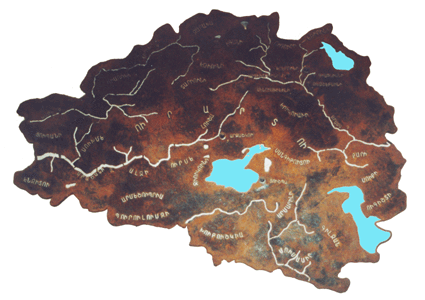
|
- Duduk (wind instrument)
|
|
Armenian oboe. A single or double reed wind instrument made of apricot wood with a sound that has a humanlike voice quality. It has a cylindrical wooden pipe, a broad reed and nine holes (8 finger-holes and one thumb-hole). It has a warm, soft, slightly nasal timbre and full tone. This instrument is equally used for slow lyrical tunes (accompanying folk songs) and faster dance-tunes and it is also played solo. The tuning is basically untempered diatonic, though chromatic notes can be obtained by partially opening or closing the finger holes. The double reed is a slit-tube-like reed. The origin of the duduk goes back to times before Christ..
|
|
- Sring (wind instrument)
|
|
Shepherd's flute of medieval Armenia. Sring is also the common term for end-blown flutes in general. These flutes are made either of a storke bone or bamboo (with the pitch of a piccolo) or wood from the apricot tree or cane and have seven or eight finger holes, producing a diatonic scale. Shepherds play on the sring various signals and tunes connected with their work, as well as the tunes of lyrical love songs called chaban byaty orl programme pieces. The sring is also played together with the def and the dhol for dance music. Specimens of sring have been found at Garni and Dvin (Armenia) and have been dated to the period between the 5th century BC and the Middle Ages. These flutes are analogous to the contemporary blul. The Armenian musicologist Komitas thought that the sring is the most characteristic among the Armenian national instruments. It originates from Eastern Armenia (Caucasus region).
|
|
- Kanun (string instrument)
|
|
The kanun is a plucked box zither of the Middle East, North Africa and parts of Asia. It is trapeziform in shape, one of the sides being rectangular. Armenian models never have more than two string-levers. To play the instruments, the musicians place it either on their knees or on a table. The strings are plucked by ring-shaped plectra put on the index fingers. The range of the kanun varies between three and four octaves. In Armenia it is played as a solo instrument or in ensembles. The instrument has 24 triple courses of gut strings tuned to a diatonic scale of D major.
|
|
- Dhol (percussion instrument ) |
|
Double-headed cylindrical drum. One membrane is thick and produces a deep sound, the other is thinner, generating a higher pitch. The membranes are made of sheepskin or goatskin, which are tensioned to each other by a variety of zigzag lacing around the cylinder. It is either played with two wooden sticks (one usually thicker than the other) on both membranes, or with the fingers and palms on one membrane. A variety of dances and songs are accompanied by the dhol. Many rhythmic patterns are used, giving the music an improvisatory character and its beat. In medieval times, the dhol was also known as the gos.
|
- more information Traditional Music and Instruments of Armenia
The Ensemble Karot (means nostalgia) was founded in 1999 by Aleksan Harutyunyan. All members of the ensemble have either studied at the Yerevan State University or at the Komitas State Conservatory. Nowadays, they teach in Yerevan the traditional music of their ancestors, choir singing, playing the traditional instruments, folk dance and the basics of music.
The repertoire of the Ensemble consists of songs that belong to the old tradition. The performance is based on the idea to preserve the songs of the different regions of Armenia, as well as to represent Armenia's "old roots" and the design of the original costumes in local traditions.
The art of Armenian folk music is as old as the Armenian nation itself. Songs reflect a people's soul like a mirror, and in this way, we can become acquainted with the traditions, the mentality, and the history of Armenian life. The Armenian people have a past with considerable historical events. Armenia was often the object of a tug-of-war between various belligerent nations, struggling to maintain national independence. After the tragedy of the 1915 massacres, Armenia recovered and gained again a foothold to continue on the way to a hopeful future.
The musicologist Komitas has described Armenian music with these words: "The songs of a people are their life; their entire life is inspired by their songs....". Because of the Armenians' difficult fate, their music is rich and of an unparalleled depth and colour. Under the influence of various foreign political and economic tendencies, Armenian musical creativity was enriched, while still following its own path and maintaining the ties to the traditions that link the past with the present.
English translation by Andranik Michaelian
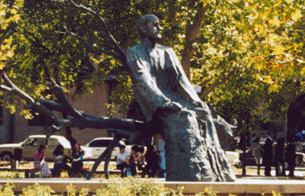
The sholar monk Komitas die Chazen - Monument in front of the conservatory in Yerevan
More information about musicians, history and religion of Armenia you will find in Ensemble Karot - Vol. I (FM 50033).
 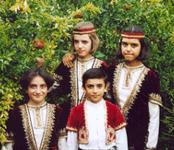
carpet museum Sardarapat - Lilit, Aroosiak, Aram, Anoosh Harutyunyan
   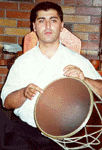
Norayr Kartashian; sring - Karine Hovhannisian; kanun - Nairi Musoyan, dukuk - Mesrop Khalatian; dhol
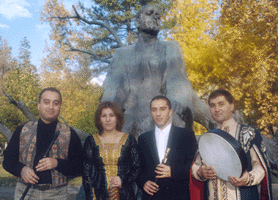
|
